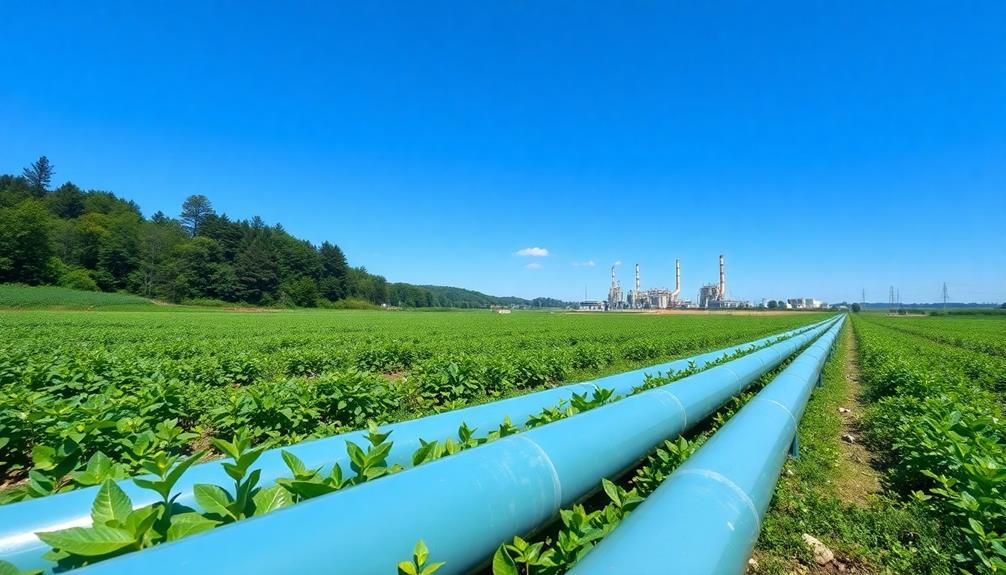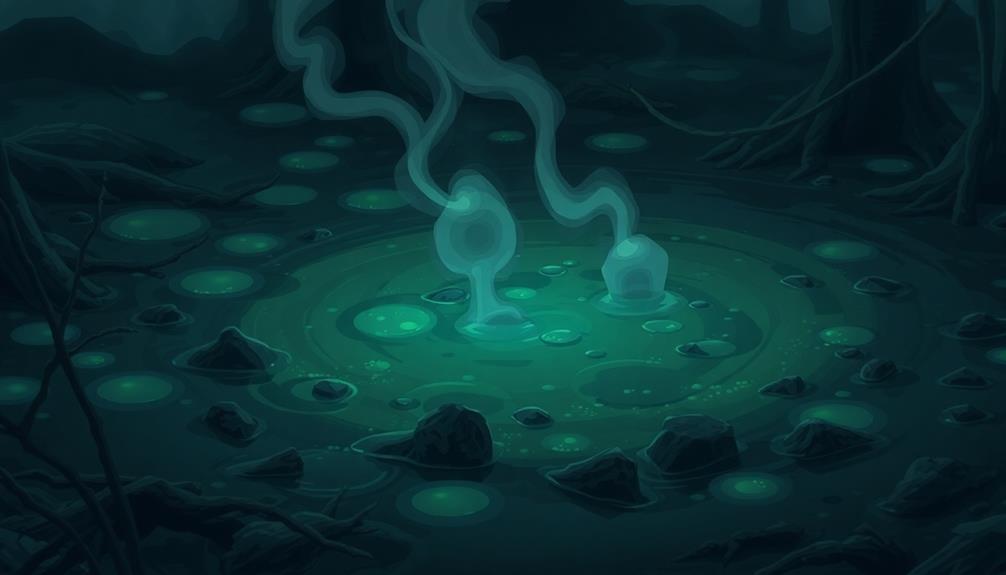Methane gas itself is odorless, which can make detecting leaks tricky. However, natural gas companies add a chemical called tert-butylthiol that gives it a distinct rotten egg smell. This added scent helps keep you safe by making leaks easier to notice. You can find methane in places like basements or near broken pipes, so it's important to pay attention to any unusual odors. If you do smell something funky, it's smart to act quickly! Remember, knowing about gas smells is vital for your safety, and there's always more to uncover about keeping your environment secure and healthy.
Key Takeaways
- Pure methane is odorless, making it difficult to detect leaks without added substances.
- Tert-Butylthiol is added to natural gas, giving it a recognizable rotten egg smell.
- Sewer gas, often containing methane, can be masked by stronger odors like hydrogen sulfide.
- Recognizing the added odor is crucial for safety to prevent health risks associated with gas leaks.
- High concentrations of methane can displace oxygen, leading to dangerous conditions if not detected.
Introduction

Methane gas is often misunderstood because, in its pure form, it's completely odorless. This can be tricky, as it means you can't smell methane unless something's been added. To keep you safe, a distinct odorant called tert-Butylthiol is mixed with natural gas, giving it that recognizable rotten egg smell. This is super important for your safety!
In addition to being aware of gas leaks, it's also crucial to understand toilet maintenance and repairs to prevent plumbing issues that could lead to unpleasant odors in your home.
When you think about sewer gas smells, remember that methane is a key component. But don't be fooled! Its odor is usually hidden behind other stinky compounds like hydrogen sulfide. That's why being aware of the added odor is crucial; it helps you spot potential gas leaks. If you ever notice a strong or unusual smell in your home, it's time to take action!
The absence of a smell in pure methane highlights how vital leak detection measures are for your plumbing system and safety. By knowing how to recognize the methane gas smell, you can protect yourself and your loved ones from health risks.
Description of the Smell

When you encounter that unmistakable smell of gas in your home, it's actually the result of the added odorant, tert-Butylthiol, rather than methane itself. Methane gas, in its pure form, is completely odorless, which makes it tricky to detect.
This is similar to how NLP enhances customer interactions by providing personalized responses—just as odorants aid in identifying gas leaks for safety. That distinct, skunk-like odor you notice when using natural gas is there for your safety! It helps you spot a gas leak before things get dangerous.
While you might smell methane when igniting your gas stove, remember that it's that added scent that makes it recognizable. In places like sewers, methane might be around, but you won't notice it because the stronger odors of hydrogen sulfide and ammonia usually take over.
This highlights how important odorants are for detecting natural gas leaks. Without that added smell, methane could escape unnoticed, leading to unsafe situations.
Source and Composition

Natural gas, primarily made up of methane, originates from both geological and biological processes. Methane is a colorless and odorless gas, which makes it tricky to detect without help. To make safety detection easier, companies add a distinct odor to natural gas. They often use a substance called tert-Butylthiol, which gives it a smell that helps you notice any leaks quickly.
Additionally, methane can also be produced through various natural processes, including the breakdown of organic materials, similar to how essential oils like eucalyptus oil can aid in respiratory health by promoting easier breathing.
Methane is produced when organic matter, like food scraps or plants, goes through decomposition. You can find this happening in places like landfills and sewer systems, where bacteria break down waste and create biogas. This biogas is rich in methane and is an important energy source.
As the simplest alkane, methane consists of just one carbon atom and four hydrogen atoms (CH4). While it's a crucial energy source, it's also important to remember that methane is a significant greenhouse gas. Its global warming potential is much greater than that of carbon dioxide over shorter periods.
Understanding the source and composition of methane can help you appreciate its role in our environment and the importance of safety measures.
Typical Scenarios or Environments

In various environments, the presence of methane poses specific risks and challenges. You might smell sewer gas in places like basements or poorly ventilated rooms where methane can accumulate.
It's important to know that common causes of sewer gas include plumbing issues, like broken pipes or clogged drains. These problems can lead to the gas found in sewer systems escaping into your home, creating unpleasant smells and potential health hazards.
If you ever notice strange odors, it's essential to act quickly. Preventing sewer gas from becoming a problem involves regular maintenance and inspections. You should always be on the lookout for signs of leaks or other plumbing issues.
Exposure to high concentrations of methane can be dangerous, so if you suspect a problem, don't hesitate to contact a professional. They can help identify the causes of sewer gas and recommend the best solutions.
Landfills and industrial sites are also common environments where methane is produced. In these places, monitoring for smells and gas concentrations is crucial for safety.
Emotional or Cultural Associations

How does the smell of methane gas affect your emotions and perceptions? The smell of sewer gas, which can be a mix of methane, causes a distinct feeling of unease. Many people associate it with danger and discomfort, often recalling safety drills or emergency protocols.
It's important to remember that while methane itself is odorless, the added scent in natural gas serves as a warning. This can trigger feelings of urgency, pushing you to act quickly.
While the smell can remind you of home cooking or heating, it also serves as a reminder to be cautious. If you ever catch a whiff of that gas, make sure you stay alert. The smell can cause irritation of the eyes and indicate a potential problem.
Prolonged exposure to harmful gases can affect your health, and in severe cases, it can lead to even death.
Culturally, we've learned to respect this smell, allowing sewer systems to operate safely while also being vigilant.
Health or Safety Considerations

One of the key safety considerations with methane gas is its potential to cause serious health risks. While methane itself is non-toxic, high concentrations can displace oxygen, creating a suffocation hazard.
If you find yourself in a confined space with elevated methane levels, you might experience dizziness or headaches, signs that your body isn't getting enough oxygen. Prolonged exposure can lead to major health issues, including lung damage, so it's essential to stay alert.
To ensure safety, regular inspections of your gas system are crucial. This includes checking clean-out caps to prevent leaks that could allow methane to escape and block sewer gas.
If a leak occurs, it can create a barrier that traps dangerous gases, leading to even riskier conditions.
Final Thoughts

Understanding the importance of detecting methane gas can significantly enhance your safety at home and in the workplace. Methane itself is odorless, but utility companies add a special scent called mercaptan to natural gas. This odor smells like a skunk and serves as a warning sign for leaks. If you ever notice a strong, unusual smell, it might be a cause for concern.
In places where sewer gas odors are present, remember that methane isn't the only gas around. It can mix with other foul-smelling gases, like hydrogen sulfide, especially during sewage backup or when decomposing organic matter is involved.
These sewer gas smells aren't just unpleasant; they can also be toxic to humans.
When you detect an odor that smells strong or unusual, it's time to take action. Evacuate the area and call for professional help immediately. Being aware of these smells helps you stay safe and proactive.
Frequently Asked Questions
Can Smelling Methane Gas Make You Sick?
Yes, smelling methane gas can make you sick if it displaces oxygen in poorly ventilated areas. You might experience dizziness or headaches, so it's essential to ensure proper ventilation and avoid high concentrations.
How Do You Know if You Have Methane Gas in Your House?
You can know if you have methane gas in your house by checking for unusual odors, unexplained gas bills, or symptoms like dizziness and headaches. If you suspect a leak, evacuate and call professionals immediately.
Does Methane Have an Odor?
No, methane itself doesn't have an odor. However, natural gas has a strong smell due to added mercaptan. If you notice that odor, it's crucial to check for leaks and ensure your safety.
What Happens When You Breathe in Methane Gas?
When you breathe in methane gas, it can displace oxygen, leading to headaches, dizziness, and fatigue. In high concentrations, it may cause unconsciousness or even death if you're in poorly ventilated areas. Stay safe!









